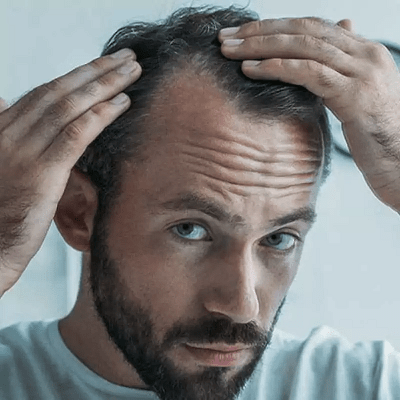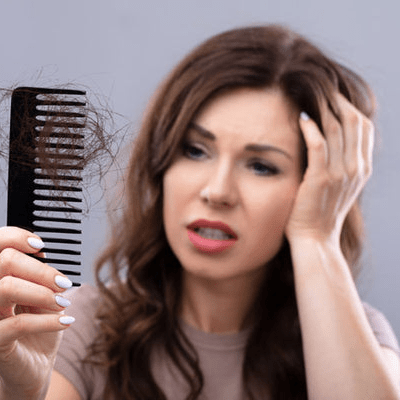
In the progressing era, people are fond of growing their hair longer and thicker. To shape their hair according to their will they use different products. If we look deep into the structure of hair, it consists of hair follicles and hair roots. The hair shaft emerges from the hair follicle and becomes the visible part of the scalp. The hair shaft is the outgrowth of the hair. The inadequate nourishment of the hair follicles causes the hair to lose. When hair follicles do not get enough protein they do not provide nutrition to the shaft. Eventually, it becomes weak and starts to shed off. In this regard, there are several Hair Loss Facts and Myths on which people rely on and choose the wrong way to cure their hair loss.
What is it?
Hair loss is a condition in which hair is lost from different parts of the body, most probably the scalp. In many cases, hair loss is considered to be a sign of an underlying cause. However, there are certain factors that cause it such as genetics, hormones, medical treatments, or certain hairstyles or treatments.
Facts and Myths:
As hair loss is a common problem that prevails in almost every society. Since every person faces hair loss at a particular age. Therefore there are several causes and myths that relate to this condition. Along with some true talks, there is also a regularity of prevaricating talks.
Facts:
The facts about hair loss are as follows
- Both men and women can have hair loss, a frequent ailment.
- Although lifestyle variables including food choices, stress, and medical issues can also contribute to hair loss. Genetics also plays a major part in the condition.
- Hair loss may happen at any age, although men seem to experience it more frequently than women.
- The average person loses about 100 hair each day; however, more than this amount may indicate excessive hair loss.
- Hair loss treatments including medication and hair transplants can aid hair restoration.
Myths:
The myths about hair loss are as follows. It is not necessary that every person gets affected by these conditions.
- Hair loss may result from excessive comb usage or hat use.
- It may result after shampooing.
- The biggest factor causing hair loss is stress.
- Hair loss is irreversible and permanent.
- Chemical procedures like dyeing and bleaching may result in hair loss.
- Tying your hair too tight also causes hair damage
Treatments:
Talking about the Hair Loss Treatment in Dubai. Both surgical and non-surgical interventions are present. However, the doctor after examining the scalp condition and amount of hair loss. He suggests the client the treatment procedure according to it.
Surgical Interventions:
It includes the surgical procedure which involves cuts and incisions on the scalp. However, make the scalp full of hair.
FUT:
In this procedure, the doctor surgically moves follicular units (groups of 1-4 hairs) from one part of the scalp to another during a hair transplant operation known as FUT (Follicular Unit Transplantation). It is regarded as the most efficient and long-lasting treatment for hair loss. The process entails taking a strip of scalp from the donor location, which is often the back or sides of the head. Then dissecting it into individual follicular units, and transplanting the follicular units into the recipient area.
FUE:
Male and female hair loss can be treated using FUE hair transplantation. It entails taking individual hair follicles (grafts) from the donor area, usually the sides or back of the head, and replacing them in bald or thinning areas at recipient locations. Using a specialized tool, the doctor removes the graft from the donor area and positions it in the recipient area, where it can develop naturally.
DHI:
A DHI implanter pen is a tool that helps during a DHI hair transplant to remove healthy hair follicles from the donor area of the scalp and then implant them into bald or thinning areas. DHI does not involve the use of a knife or sutures, in contrast to conventional hair transplant techniques. The DHI implanter pen enables the implantation of one hair follicle at a time, resulting in a less-scarred, more natural-looking, denser hairline.
Non-Surgical Interventions:
The following are the non-invasive options to treat hair loss.
Topical Medications:
Topical medications are medications that are applied topically. The topical medication the doctor mostly suggests to treat hair loss is minoxidil (Rogaine) and finasteride (Propecia). However, some doctors also advise using a topical steroid solution such as clobetasol propionate (Temovate) to treat different types of hair loss.
PRP:
The medical technique known as PRP (Platelet Rich Plasma) therapy involves injecting the scalp of the patient with a concentrated solution of their own platelets. Growth factors that are present in the platelets encourage the scalp to create new hair follicles and promote hair growth. PRP treatment helps to treat hair loss in both men and women.
Laser:
laser therapy is a non-intrusive treatment that helps to treat hair loss. It stimulates hair follicles and boosts blood flow to the scalp using low-level laser light to promote hair growth. Male pattern baldness, androgenetic alopecia, and thinning hair have all been successfully treated with laser treatment. It is a painless and secure procedure that causes no side effects.
Book A Consultation!
Most people want to get clarity about Hair Loss Facts and Myths that are present in society. Dynamic Aesthetic Clinic offers the best and most effective treatment for hair loss. We have well-qualified doctors that are ambitious to clear all the concerns of the clients. Therefore, if you are on the edge of giving up on trying the remedies for your hair loss. Then get your treatment now. Fill out the consultation form and book your appointment now to treat your hair loss.


































